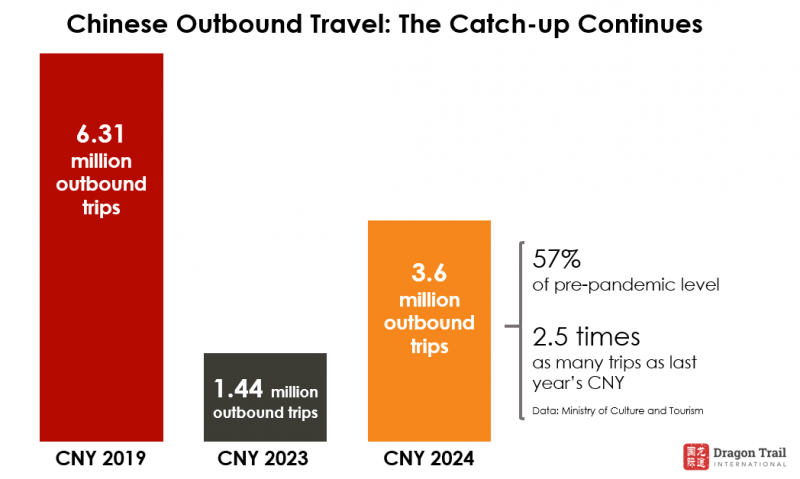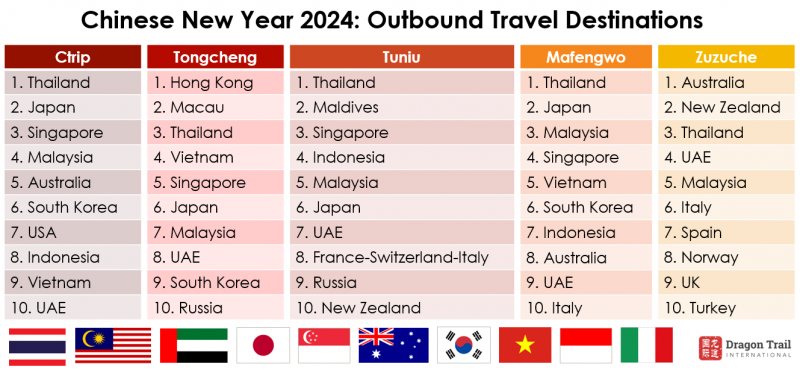While 2023 was the year when China reopened following the COVID-19 pandemic, it was only in 2024 that the country celebrated its first Chinese New Year with no pandemic-related restrictions on outbound travel. What did China’s outbound travel market look like this past Spring Festival, and what does that tell us about its ongoing recovery? For our March 2024 webinar, Dragon Trail pored over data and reports from government ministries, OTAs, travel websites, flight analytics companies, and overseas payment providers to present a comprehensive picture of Chinese outbound tourism during the first “normal” Chinese New Year since the pandemic began.
Outbound Travel by the Numbers
According to China’s Ministry of Culture and Tourism, there were 3.6 million outbound trips taken during the CNY period. This is only 57% of 2019’s 6.31 million trips – in contrast to the number of domestic trips this year, which actually surpassed pre-pandemic levels by 19%. However, comparisons with 2023’s Chinese New Year offer a better understanding of how much progress has been made.

By every way we can measure it, the rate of recovery for outbound travel compared to last year is significant. Year on year, the number of outbound trips was up by two and a half times. Last January, which is when Chinese New Year fell in 2023, international flight capacity had reached only 11% of 2019’s level. This year it was more than 70% recovered, with some destinations like Singapore, the UAE, the UK, and Italy already exceeding pre-pandemic levels. Overseas spending – based on Alipay transactions over the holiday period – recovered to 82% of 2019’s volume, nearly two and a half times more than last year.
For Chinese OTAs, year-on-year growth rates for outbound travel were staggering. The reason for this is that, from a policy standpoint, 2024 is only the first “normal” year for outbound travel since the pandemic. Last year, while overseas travel was no longer officially discouraged, travel agencies were still banned from selling outbound group tours, or packages that included a minimum of a flight and hotel booking together. These restrictions on the sale of outbound group and package travel did not start to be removed until early February of last year, after Chinese New Year was over. At present, the sale of group tourism is permitted to 138 countries, which is even more than pre-pandemic.
With travel packages and group tours back on the table, Ctrip reported that tourism orders exceeded the same period in 2019. Fliggy’s outbound travel bookings increased nearly 10 times. Qunar’s outbound flight bookings increased by 14 times, with hotel bookings for overseas destinations up by 4.7 times. Car rental platform Zuzuche reported a 730% year on year increase in outbound travel rental orders, alongside a 56% increase for domestic orders.
Outbound Travel Destination Trends
There were two main destination trends for Chinese outbound tourism over the 2024 Chinese New Year period: 1) The newly visa-free Singapore, Malaysia, and Thailand; and 2) the rise of the Middle East and North Africa (MENA) region.
It should come as no surprise that Thailand tops most destination lists released by OTAs, as it’s been the number one destination for Chinese outbound travel for many years already. The new visa-free policy only adds to its appeal and ease of travel. Singapore and Malaysia have gotten an even bigger boost from going visa-free. OTA Qunar, for example, reported that bookings for travel to Singapore were 29 times greater than in 2023, with bookings to Malaysia up by 20 times. Flight data reported by ForwardKeys showed a 24% year-on-year growth for Chinese arrivals to Kuala Lumpur, and 4% growth for Singapore.

Apart from Thailand and Malaysia, the other country that is on all the top destination lists from Ctrip, Tongcheng, Tuniu, Mafengwo, and Zuzuche is the United Arab Emirates. The UAE is also visa-free for Chinese visitors, benefits from strong flight connections, and is enjoying a lot of popularity right now, as is the whole MENA region. ForwardKeys’ data shows that Chinese arrivals to the Middle East were 2% ahead of 2019 levels this year. Their report notes that Cairo in particular saw a 7% increase in Chinese arrivals, beyond pre-pandemic levels.
Mafengwo’s list of top 20 outbound countries with increasing demand for Chinese New Year 2024 compared to one year earlier includes the UAE, Saudi Arabia, Qatar, Egypt, and Morocco. All of these five countries offer visa-free entry or visas on arrival to Chinese citizens. Qunar reported that outbound orders for the UAE, Egypt, and Morocco were three times higher than the year before, with a 10-fold increase for Dubai. Fliggy reported that travel orders for Egypt increased by 15 times year on year. And Zuzuche’s top 10 outbound destinations with the highest growth rates for car rentals included Abu Dhabi and Riyadh.
Spring Festival: A Family Holiday
Whether domestic or international, the biggest theme for Chinese New Year travel was family. This is traditionally the main holiday period for family travel, and that was definitely true in 2024. 45% of Mafengwo’s users travelled with family over the holiday. Travel with children and with parents made up the majority of both domestic and outbound travel orders on Ctrip. Family travel also dominated self-driving travel, according to Zuzuche, making up 44% of car rentals in New Zealand, and 38% in Australia. Zuzuche’s data indicates that family travelers spend more and travel for slightly longer, making this a valuable market segment.
A “dark horse” this Chinese New Year for both domestic and outbound tourism was cruise travel. Reservations and cruise traveler numbers skyrocketed compared to last year. The top international cruise route was Shanghai to Okinawa, and the newly launched Adora Magic City, the first-ever made-in-China large cruise ship, received a lot of attention. The popularity of cruises was strongly related to the prominence of family travel over Chinese New Year, as cruise travel is seen as an easy and comfortable option for traveling with both young children and elderly parents.
What’s coming next in 2024 for Chinese outbound travel?
We expect the market to continue to recover at a decent pace, reaching around 80% of pre-pandemic levels by the end of this year, and then reaching or surpassing 2019’s number of outbound trips in 2025.
As we just saw at Chinese New Year, this recovery is going to have an uneven speed around the world. Some destinations, particularly in the Middle East, can expect to see Chinese tourism grow beyond pre-pandemic levels already this year. Certain Asian destinations could also fully catch up this year, while others might take longer. Europe, Oceania, and Africa will be a bit slower but are all making progress, while the Americas will likely take the longest to recover, though there has been some positive recent news about increased flight capacity to the US and Mexico.
The next big Chinese travel periods to look forward to are the five-day Labor Day holiday at the start of May, followed by the summer travel season (the most popular choice for when to travel outbound in a recent survey from the OTA Tongcheng), and then October’s Golden Week.
Click here to watch the full recording of Dragon Trail’s March 2024 webinar on CNY travel trends. Contact us to request the presentation slides.
Sign up for our free newsletter to keep up to date on our latest news
We do not share your details with any third parties. View our privacy policy.
This website or its third party tools use cookies, which are necessary to its functioning and required to achieve the purposes illustrated in the cookie policy. If you want to know more or withdraw your consent to all or some of the cookies, please refer to the cookie policy. By closing this banner, scrolling this page, clicking a link or continuing to browse otherwise, you agree to the use of cookies.